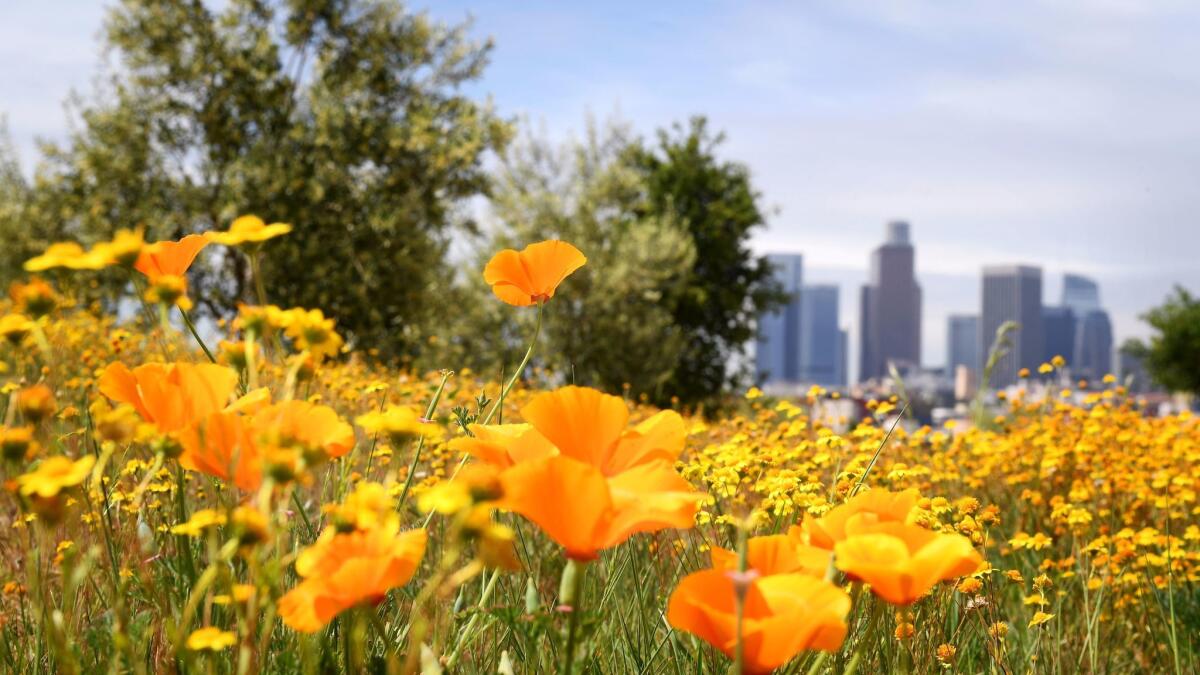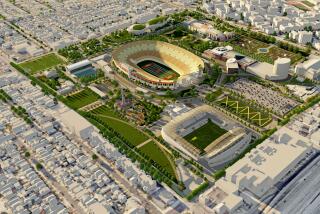The refurbished Los Angeles State Historic Park could become one of the city’s best spots for live music

- Share via
After the 2008 recession, funding for a full renovation of Los Angeles State Historic Park seemed far off. Though the park had been waiting for a thorough face-lift since the state bought the 32-acre former rail yard at the crux of Chinatown and Echo Park in 2001, a refurbishment amid a sluggish economy wasn’t necessarily an easy sell.
But in 2009, an Echo Park punk rock festival needed a bigger venue. After a profanity-trimming name change, FYF Fest had found a home just off the Gold Line, and the park had a reliable new income stream.
Hard Summer and others came next, and Los Angeles State Historic Park became known as one of the best places to throw a music festival in Southern California.
“We didn’t have the funding then, but we wanted to build public support and awareness for the site after the economy collapsed,” said Sean Woods, the superintendent of California State Parks in the Los Angeles sector. “We wanted to demonstrate that we could be self-sufficient, and though we didn’t have much experience in the music business, we could demonstrate that [renovations] wouldn’t have an impact on the general fund. The fact that [the site] wasn’t built out meant that we had a lot of flexibility.”
The popularity of those music festivals helped build a constituency for the full revamp of the park, which finally reopened to the public last week. Now that it’s undergone a widely praised renovation, how does music fit into its future?
In the three years since its closure, both FYF and Hard Summer have outgrown the park’s now 25,000-person capacity (down from 35,000 before the remodel).
Woods said that a diverse range of music festivals will still have a place in the new park. They just might be smaller — initially in the 10,000 capacity range — and more closely balanced with the needs of daily park-goers.
Those changes will likely include fewer shows (“we’re only looking to do four or five all season,” Woods said), earlier curfews, keeping segments of the park open during concerts, and doing more non-music events such as film screenings, educational events and food festivals.
“The purpose of the park is to be a public park first. We’re very mindful of noise levels and want to avoid closing to the public as often as possible,” Woods said.
But he also knows that “it’s a magnificent location [for music festivals], and we understand the value of that.”
Early signs suggest promoters are eager to get back into Los Angeles State Historic Park.
The first few festivals coming to the park fit right in line with the FYF-going crowd. Coming May 20 is the new Skyline Festival, a KCRW-aligned gig with electronic acts Miike Snow, Duke Dumont and Lido, among others.
Later in the fall, FYF will dip its toes back into programming there, presenting a 15th anniversary show from Interpol playing its album “Turn on the Bright Lights.”
Representatives for Hard wouldn’t comment on any potential plans to return to Los Angeles State Historic Park (last year, Hard Summer drew 147,000 fans over two days to the Auto Club Speedway in Fontana). But FYF fans who still hold a soft spot for the clatter of the Gold Line and skyscrapers in the sunset should be encouraged that they’re among the first promoters to get on board with smaller shows.
Dave Peterson, a co-producer of FYF Fest, said, “FYF became a ‘festival’ upon moving to the park. The Los Angeles skyline as seen from the park was certainly a huge part of the visual identity of the festival during those years. There is a huge feeling of nostalgia and ‘coming home’ that is undeniable. We know how special the park is for anyone who came to FYF in the past and are thrilled to bring shows to the new Los Angeles State Historic Park.”
Woods said that the parks department is actively looking for more diversity in its musical programming (a Latin music festival is a top priority, he said). Renovations like a new amphitheater space, permanent restrooms, a forthcoming restaurant and a dramatic elevated walking path will make for an even more functional and striking venue for music.
Nearby Grand Park proved to be a popular place for free cultural events, and Woods stressed that the new park’s civic role comes first, and any revenue-generating concerts will have to allow for that priority.
When Los Angeles State Historic eventually links up to two other proposed park developments along the Los Angeles River, at the Bowtie and Rio de Los Angeles plots, it could herald a whole new approach to how culture interacts with public land in Los Angeles.
Festivals might have to learn to share a bit more of the space, however.
“[The park] is surrounded by some of the oldest neighborhoods in L.A., and there has to be respect for what came before,” Woods said. “You have to reach out to urban communities and diverse people to build support for parks.”
For breaking music news, follow @augustbrown on Twitter.
ALSO:
More to Read
The biggest entertainment stories
Get our big stories about Hollywood, film, television, music, arts, culture and more right in your inbox as soon as they publish.
You may occasionally receive promotional content from the Los Angeles Times.











